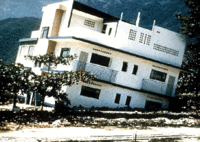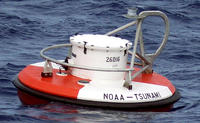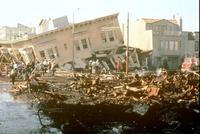-
Lessons from Japan's tsunami could dramatically shift building codes
American tsunami experts and engineers are scouring the devastation wrought by the 11 March earthquake and tsunami to analyze how structures fared during the natural disasters and what lessons can be applied to U.S. building codes; experts are particularly concerned about the toppling of a reinforced-concrete building as that has been the baseline for tsunami construction and evacuation procedures; experts were stunned by the devastation and are concerned about America’s West Coast which is significantly less prepared than Japan for an earthquake or tsunami; in particular experts are concerned about Oregon which shares many geological similarities to Japan’s northeastern coast; researchers hope to learn valuable lessons that will minimize the destruction from a similar event in the United States
-
-
Much of earthquake damage in Japan caused by "liquefaction"

The massive subduction zone earthquake in Japan caused a significant level of soil “liquefaction” that has surprised researchers with its widespread severity, a new analysis shows; the findings also raise questions about whether existing building codes and engineering technologies are adequately accounting for this phenomenon in other vulnerable locations, which in the United States include Portland, Oregon, parts of the Willamette Valley, and other areas of Oregon, Washington, and California
-
-
U.S. tsunami warning system outdated

The two tsunami warning centers the National Oceanic and Atmospheric Administration (NOAA) operates are “remarkably outdated” and need upgrades, experts say; both centers need upgrades with common sets of hardware and software tools, which both lack today; it is estimated that design of the architecture and purchase of new hardware would cost about $2 million — a small investment to improve the warnings of potentially devastating events
-
-
N.J. receives $5.7 million for seventeen police departments
Earlier this month the Department of Justice awarded New Jersey $5.7 million in grants to help seventeen local police departments; the grants are specifically aimed at purchasing surveillance equipment like closed-circuit cameras, gunshot detection systems, and mobile data centers; each city will receive either $250,000 or $500,000 based on the city’s size and violent crime; surveillance technology has already proven effective in helping New Jersey police departments track down and convict criminals; New Jersey’s attorney general is encouraging police departments to consider regionalizing and consolidating functions as the grants can be used to purchase equipment to create regional dispatch systems
-
-
Twitter and natural disasters: lessons from Japan
Researchers from Kobe City University of Foreign Studies surveyed and questioned Twitter users and tracked updates from people in the disaster-struck area on the social media site two weeks after the Tohoku earthquake and devastating tsunami of 11 March; Twitter was the only functioning communication tool immediately after the earthquake; the researchers found that there benefits for using Twitter, such as bringing information to people involved in a disaster and to those hoping to hear news; there was a downside, though: Twitter helped spread unverified rumors and misinformation, causing people to panic in areas where there was no reason to panic, thus making the work of rescuers and service authorities more difficult; one solution: have the government itself use Twitter to offer reliable information to all involved
-
-
NY emergency services communication not up to snuff
Nearly ten years after the 9/11 attacks, many police officers and first responders in New York still carry radios that cannot communicate with fellow emergency services personnel working for other agencies and jurisdictions; often, they use their personal cell phones during an operation; state lawmakers want this situation changed
-
-
Disaster-zone phone communication software available for free
Australian researchers developed software which enables mobile phones to communicate during a disaster; it will be freely available to the public by the end of the year thanks to the support of the Dutch NLnet Foundation; the software can be used on compatible mobile phone handsets to create an alternative “network” where conventional mobile phone coverage has been destroyed or does not exist
-
-
Streamlined approach to U.S. preparedness
The administration has released a new presidential policy directive on national preparedness; the directive, the result of a comprehensive review of national preparedness policy, replaces Homeland Security Presidential Directive 8; the administration says that the directive seeks to move away from burdensome requirements and instead build the key capabilities the nation needs to confront any challenge
-
-
Report finds Coast Guard unprepared for BP oil spill
An internal review by the U.S. Coast Guard found that its response to the colossal Deep Water Horizon oil spill in the Gulf of Mexico last year was hindered by its lack of preparation and reduced response capabilities; the 158 page review said that the government and private sector “demonstrated a serious deficiency in planning and preparedness for an uncontrolled release of oil from an offshore drilling operation”; in response to the review, R. J. Rapp Jr., the commandant of the Coast guard, said that his agency would pay greater attention to industry oil-spill response plans, begin preparing for future accidents, and conduct a study on the large use of chemical dispersants on the environment
-
-
Waste management critical to natural disaster recovery
Disasters can typically generate up to fifteen years worth of a community’s solid waste over a few days, with the potential to overwhelm day-to-day solid waste operations and to lead to years of disruption; FEMA estimates that debris removal accounted for 27 percent of their total disaster response costs for those U.S. disasters between 2002 and 2007; prolonged problems with the management of solid waste can lead to public and environmental health issues; slow management of solid waste can also impede economic recovery by inhibiting rebuilding activities
-
-
Japan sets up reconstruction planning structure
Japan has announced that three newly created bodies will be in charge of Japan’s reconstruction: a 15-member panel of experts called the Reconstruction Design Council which will offer plans and programs for reconstruction; a cabinet task force, in which all cabinet members will be members, which will be responsible for implementing the programs; and a panel of reconstruction of the ruling Democratic Party of Japan, which will be in charge of coordinating relevant policies with the opposition parties
-
-
Five U.S. nuclear plants in earthquake zones
Five active U.S. nuclear reactors — the Diablo Canyon Power Plant and San Onofre Nuclear Generating Station in California; the South Texas Project near the Gulf Coast; the Waterford Steam Electric Station in Louisiana; and the Brunswick Steam Electric Plant in North Carolina — are situated in seismic activity-prone zones
-
-
Easing contamination fears in Japan's food industry

With much of Japan’s manufacturing sector, land, and critical infrastructure badly damaged from the March 11 earthquake and tsunami, dairy and rice manufacturers have struggled to produce enough to feed the nation; Japan produces all of its own milk, rice, and yogurt products, but domestic plants are operating far below full capacity; shortages may persist into the summer; as production ramps up, fears of contamination from radiation leaked from the Fukushima Daiichi nuclear power plant may dampen consumption; one analyst suggests that Japan institute a food tracking program that will allow consumers to track the production of food every step of the way to help ease fears
-
-
Geologists push for earthquake early warning system despite costs

Geologists on the West Coast are actively pushing for an earthquake early warning system, similar to the one deployed in Japan; the Japanese warning system helped save lives as it gave people valuable extra time to prepare before the devastating 9.0 magnitude earthquake and tsunami hit; scientists want to place a similar network of data transmitters and information receivers along fault lines up and down the West Coast; geologists fear that a major impediment to the installation of the system would be its cost during times of fiscal austerity; the system would take roughly ten years to build and an estimated $145 million, making the project nearly impossible to undertake without federal funding
-
-
Portable military barriers help Canadian city in flood fight
Canada is using a new technology to prevent flood damage in Manitoba; the one-meter-square wire cages can be unfolded and quickly filled with dirt or mud; they can also be linked for a long row that can be set up far quicker than it takes to sling sandbags; the barriers have been used by the U.S. military to protect embassies from terrorist attacks, and have also been used for flood protection in the United States
-
More headlines
The long view
Using Drone Swarms to Fight Forest Fires
Forest fires are becoming increasingly catastrophic across the world, accelerated by climate change. Researchers are using multiple swarms of drones to tackle natural disasters like forest fires.
How Climate Change Will Affect Conflict and U.S. Military Operations
“People talk about climate change as a threat multiplier,” said Karen Sudkamp, an associate director of the Infrastructure, Immigration, and Security Operations Program within the RAND Homeland Security Research Division. “But at what point do we need to start talking about the threat multiplier actually becoming a significant threat all its own?”
